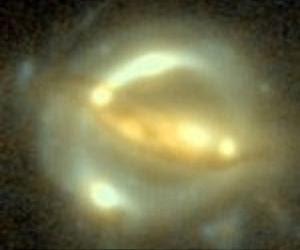 When a large nearby object, such as a galaxy, blocks a distant object, such as another galaxy, the light can detour around the blockage. But instead of taking a single path, light can bend around the object in one of two, or four different routes, thus doubling or quadrupling the amount of information scientists receive.
When a large nearby object, such as a galaxy, blocks a distant object, such as another galaxy, the light can detour around the blockage. But instead of taking a single path, light can bend around the object in one of two, or four different routes, thus doubling or quadrupling the amount of information scientists receive.As the brightness of the background galaxy nucleus fluctuates, physicists can measure the ebb and flow of light from the four distinct paths, such as in the B1608+656 system imaged above. (Image courtesy Sherry Suyu of the Argelander Institut fur Astronomie in Bonn, Germany.)
Using entire galaxies as lenses to look at other galaxies, researchers have a newly precise way to measure the size and age of the universe and how rapidly it is expanding, on a par with other techniques.
The measurement determines a value for the Hubble constant, which indicates the size of the universe, and confirms the age of the universe as 13.75 billion years old, within 170 million years. The results also confirm the strength of dark energy, responsible for accelerating the expansion of the universe.
These results, by researchers at the Kavli Institute for Particle Astrophysics and Cosmology (KIPAC) at the US Department of Energy's SLAC National Accelerator Laboratory and Stanford University, the University of Bonn, and other institutions in the United States and Germany, will be published in The Astrophysical Journal in March.
The researchers used data collected by the NASA/ESA Hubble Space Telescope, and showed the improved precision they provide in combination with the Wilkinson Microwave Anisotropy Probe (WMAP).
The team used a technique called gravitational lensing to measure the distances light traveled from a bright, active galaxy to the earth along different paths. By understanding the time it took to travel along each path and the effective speeds involved, researchers could infer not just how far away the galaxy lies but also the overall scale of the universe and some details of its expansion.
Oftentimes it is difficult for scientists to distinguish between a very bright light far away and a dimmer source lying much closer. A gravitational lens circumvents this problem by providing multiple clues as to the distance light travels. That extra information allows them to determine the size of the universe, often expressed by astrophysicists in terms of a quantity called Hubble's constant.
"We've known for a long time that lensing is capable of making a physical measurement of Hubble's constant," KIPAC's Phil Marshall said. However, gravitational lensing had never before been used in such a precise way. This measurement provides an equally precise measurement of Hubble's constant as long-established tools such as observation of supernovae and the cosmic microwave background. "Gravitational lensing has come of age as a competitive tool in the astrophysicist's toolkit," Marshall said.






No comments:
Post a Comment